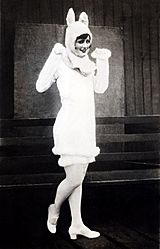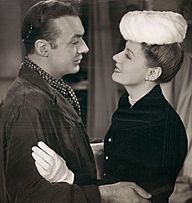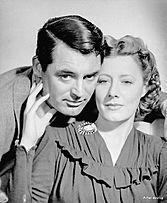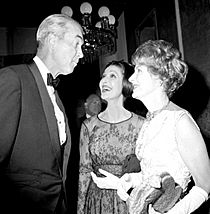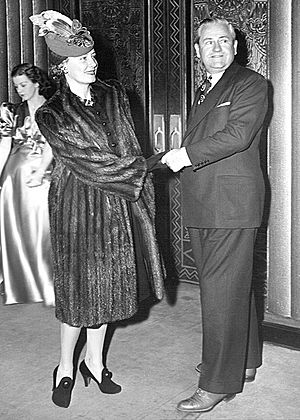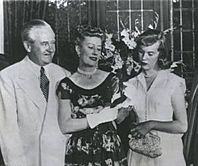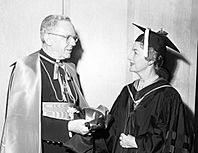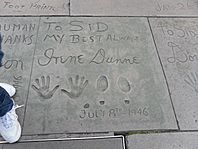Irene Dunne facts for kids
Quick facts for kids
Irene Dunne
DHS
|
|
|---|---|

Studio headshot of Dunne, c. 1938
|
|
| Born |
Irene Marie Dunn
December 20, 1898 Louisville, Kentucky, U.S.
|
| Died | September 4, 1990 (aged 91) Los Angeles, California, U.S.
|
| Other names |
|
| Alma mater |
|
| Occupation |
|
| Years active | 1922–1987 |
| Title |
|
| Political party | Republican |
| Board member of |
|
| Spouse(s) |
Francis Dennis Griffin
(m. 1927; died 1965) |
| Children | 1 |
| Awards | See list |
| Musical career | |
| Genres |
|
| Instruments |
|
| Labels | Decca Records |
Irene Dunne (born Irene Marie Dunn; December 20, 1898 – September 4, 1990) was an American actress, singer, and a person who helped others through charity. She starred in movies during the Golden Age of Hollywood. She was famous for her funny roles, but she also acted in many other types of films.
When Irene was 14, her father passed away, and her family moved from Kentucky to Indiana. She really wanted to become an opera singer. But when she wasn't accepted by the Met, she performed in musicals on Broadway. Later, a talent scout from RKO discovered her, and she made her first Hollywood movie, Leathernecking (1930). She also starred in the popular musical Show Boat (1936).
Irene Dunne acted in 42 movies. She was nominated five times for the Academy Award for Best Actress (an Oscar) for her roles in:
- the drama Cimarron (1931)
- the comedies Theodora Goes Wild (1936) and The Awful Truth (1937)
- the romance Love Affair (1939)
- the drama I Remember Mama (1948)
Many people think Irene Dunne was one of the best actresses who never won an Oscar. Some critics believe her acting has been forgotten, often because her movies were remade later or she acted with more famous co-stars.
After the success of The Awful Truth, she acted with Cary Grant two more times. They starred in another comedy, My Favorite Wife (1940), and a drama, Penny Serenade (1941). Many people praised her as one of the best comedy actresses in the screwball comedy style. Her movie Love Affair was so popular that she made two more films with her co-star, Charles Boyer: When Tomorrow Comes (1939) and Together Again (1944).
Her last movie role was in 1952. After that, she acted in and hosted many TV shows until 1962. She also performed on radio from the late 1930s to the early 1950s. She was called "The First Lady of Hollywood" because she seemed very graceful and elegant. But she was also proud of her Irish-American, country-girl background.
After she stopped acting, Irene Dunne spent her time helping others. President Dwight D. Eisenhower chose her to be a delegate for the United States at the United Nations. There, she spoke about world peace and helped with programs for refugees. She also spent time with her family: her husband, Dr. Francis Griffin, and their adopted daughter, Mary Frances.
She received many awards for her charity work, including special degrees from universities, a Laetare Medal from the University of Notre Dame, and a special honor from the Pope, making her a Dame of the Order of the Holy Sepulchre. In 1985, she received a Kennedy Center Honor for her contributions to the arts.
Contents
Early Life and Dreams
Irene Marie Dunn was born on December 20, 1898, in Louisville, Kentucky. Her father, Joseph John Dunn, was an Irish-American engineer. Her mother, Adelaide Antoinette Dunn, was a concert pianist and music teacher. Irene was their second child. Her family often moved between Kentucky and St. Louis because of her father's job.
When Irene was 14, her father died in April 1913. She always remembered what he told her the night before he passed away: "Happiness is never an accident. It is the prize we get when we choose wisely from life's great stores."
After her father's death, Irene's family moved to her mother's hometown of Madison, Indiana. Irene's mother taught her to play the piano when she was very young. Irene said, "Music was as natural as breathing in our house." She started to love drama after being in her first school play, A Midsummer Night's Dream. She also took singing lessons and sang in churches and high school plays.
After graduating in 1916, she studied at the Indianapolis Conservatory of Music. She earned a diploma in 1918. Later, she won a scholarship to the Chicago Musical College and graduated in 1926. She dreamed of becoming a soprano opera singer and moved to New York in 1920. However, she didn't get into the Metropolitan Opera Company because she was too new and her voice was "slight."
Becoming a Star
First Steps in Acting
Irene Dunne took more singing and dancing lessons to prepare for a career in musical theater. She got her first big role in a play called Irene, which traveled to many cities in 1921. Her first time acting on Broadway was on December 25, 1922, in a show called The Clinging Vine. She later got the main role in that show in 1924.
She then had supporting roles in other musicals like The City Chap (1925), Yours Truly (1927), and She's My Baby (1928). Her first main role, Luckee Girl (1928), wasn't as successful. Around this time, Irene added an extra "e" to her last name, changing it from Dunn to Dunne.
A big break came when she met director Florenz Ziegfeld Jr. by chance. He offered her the role of Magnolia Hawks in a traveling version of Show Boat. A talent scout from RKO Pictures saw her perform and offered her a movie contract. Her first film was Leathernecking (1930). Irene was already in her 30s when she started in movies, so she often avoided talking about her age. Publicists sometimes said she was born in 1901 or 1904 to make her seem younger.
Hollywood's Leading Lady
After the "Hollywood musical" trend ended, Irene Dunne started acting in dramas. She successfully campaigned for the role of Sabra in Cimarron (1931), which earned her first Oscar nomination for Best Actress. A magazine called Photoplay said this movie made her "one of our greatest screen artists."
She also starred in dramas like Back Street (1932) and No Other Woman (1933). For Magnificent Obsession (1935), she learned Braille and worked on her posture to play a blind character.
In 1936, she starred again as Magnolia Hawks in Show Boat, directed by James Whale. Irene loved filming the scene "Make Believe" because it reminded her of Romeo and Juliet. That same year, her contract with Warner Bros. ended, and she decided to become a freelance actress. This meant she could choose which studios and directors to work with.
She was nervous about trying her first comedy role in Theodora Goes Wild (1936). But she found she really enjoyed making the movie and received her second Oscar nomination for it.
After Theodora Goes Wild, Irene Dunne acted in more romantic comedies. The Awful Truth (1937) was the first of three movies she made with Cary Grant. This film was later voted the 68th best comedy in American cinema history. Their comedy My Favorite Wife (1940) was also highly praised. They also made a drama together, Penny Serenade (1941). Irene Dunne and Cary Grant were seen as one of the best romantic comedy pairs.
Irene Dunne also starred in three films with Charles Boyer: Love Affair (1939), When Tomorrow Comes (1939), and Together Again (1944). Love Affair was a huge success. People loved Irene Dunne and Charles Boyer as a romantic duo.
Irene Dunne showed she could act in many different types of movies. Critics liked her comedic skills in Unfinished Business (1941) and Lady in a Jam (1942). When the United States entered World War II, Irene helped by going on tours to sell war bonds. She said, "This is no time for comedy. I'm now a saleswoman, I sell bonds."
She then starred in two war films: A Guy Named Joe (1943) and The White Cliffs of Dover (1944). A Guy Named Joe was one of the most successful films that year. In Over 21 (1945), she returned to comedy.
Later, she played strong but kind motherly roles. These included Anna Leonowens in Anna and the King of Siam (1946), Vinnie Day in Life with Father (1947), and Marta Hanson in I Remember Mama (1948). For I Remember Mama, Irene worked on her Norwegian accent and wore padding to look heavier. Marta Hanson was her fifth and final Oscar nomination for Best Actress.
Later Career and TV
Irene Dunne's last three films didn't do well at the box office. The comedy Never a Dull Moment (1950) was criticized for trying too hard. She was excited to play Queen Victoria in The Mudlark (1950) because she could "hide" behind heavy makeup and prosthetics. This film was popular in the UK, but American fans didn't like the prosthetics. The comedy It Grows on Trees (1952) was Irene Dunne's last movie.
She also starred in and hosted many television anthology shows, like Ford Theatre and General Electric Theater. Her last acting role was in 1962. Irene Dunne never officially retired. She said, "I never formally retired, but an awful lot of the girls my age soldiered on in bad vehicles. [I] couldn't run around with an ax in my hand like Bette [Davis] and Joan [Crawford] did to keep things going."
Life After Movies
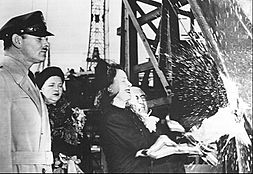
After her movie career, Irene Dunne continued to be active. She presented at the 1950 BAFTAs in London and represented Hollywood at the 12th Venice International Film Festival in 1951. She also appeared at the March of Dimes event in New York City in 1953 to support polio research.
In 1955, she accepted Walt Disney's invitation to present at Disneyland's "Dedication Day." She christened the Mark Twain Riverboat with water from major rivers across the United States. Years before, she had also christened the SS Carole Lombard, a ship named after the actress.
Irene Dunne was the only actress to be part of the California Arts Commission from 1967 to 1970. During this time, she helped create a museum exhibit called "Dimension" for visually impaired visitors. It opened in 1970 and toured California. Irene recorded a special audio guide for the exhibit, explaining the sculptures and inviting guests to touch them.
Helping Others
During World War II, Irene Dunne joined the Beverly Hills United Service Organization. She also helped start the Clark Gable's Hollywood Victory Committee. This group organized entertainment for servicemen and tours to sell war bonds. She received an award from the Treasury Department for her work.
In her retirement, she focused on helping people. She worked with many organizations, including the Sister Kenny Foundation, the American Cancer Society, the Los Angeles Orphanage, and the American Red Cross. In 1950, she became president of Santa Monica's St. John's Hospital and Health Clinic. She also became the first woman elected to the board of directors for Technicolor in 1965.
She helped establish a school for African Americans in Los Angeles and raised money for St. John's Hospital. She also helped with the Hebrew University Rebuilding Fund. In 1949, she was appointed chairwoman for the American Heart Association's women's committee. She appeared in a TV special called Benefit Show for Retarded Children (1955). Irene also donated money to help restore places in her childhood hometown of Madison, Indiana. In 1987, she founded the Irene Dunne Guild, which has raised millions of dollars to support St. John's Hospital.
Irene Dunne said in 1951: "If I began living in Hollywood today, I would certainly do one thing that I did when I arrived, and that is to be active in charity. If one is going to take something out of a community—any community—one must put something in, too."
Working for World Peace
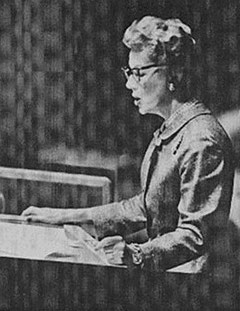
In 1957, President Eisenhower chose Irene Dunne to be one of the U.S. delegates to the United Nations. He recognized her interest in world affairs and her Catholic and Republican beliefs. Irene admired the U.N.'s goal of creating world peace.
She was sworn in on September 12, 1957, with other delegates. She served as a delegate for two years and spoke twice at the General Assembly. She even called the song "Getting to Know You" the anthem for her delegacy because it's "so simple, and yet so fundamental in international relations today." Irene said her "biggest thrill" was asking the Assembly for $21 million to help Palestinian refugees. She called her time as a delegate the "highlight of my life." She was very impressed with the U.N.'s work, especially with UNICEF (which helps children) and the health organization.
Political Views
Irene Dunne was a lifelong member of the Republican Party. She was part of California's delegation at the 1948 Republican National Convention. She also campaigned for Thomas Dewey in the 1944 United States presidential election and Ronald Reagan in the 1966 California gubernatorial election. She accepted the U.N. delegate offer because she saw the U.N. as a non-political organization. She explained, "I'm a Nixon Republican, not a Goldwater one. I don't like extremism in any case. The extreme rights do as much harm as the extreme lefts."
Personal Life
Irene Dunne loved riverboat rides and parades, remembering trips down the Mississippi River with her father. She said, "No triumph of either my stage or screen career has ever rivaled the excitement of trips down the Mississippi on the riverboats with my father."
She was a keen golfer and often played with her husband. They socialized with business people in California. Irene was good friends with many stars like Loretta Young, Jimmy Stewart, Bob Hope, Rosalind Russell, Van Johnson, Ronald Reagan, Carole Lombard, and George Stevens Jr.. She was also the godmother to Loretta Young's son, Peter.
Her school friends called her "Dunnie." Director John Cromwell once said she "always [had] the look of a cat who had swallowed the canary."
Irene Dunne was popular with her co-workers and known for being warm and friendly. She had a "poised, gracious manner" like royalty, which also showed in her movies. She earned the nickname "The First Lady of Hollywood." Director Leo McCarey said, "If Irene Dunne isn't the first lady of Hollywood, then she's the last one." This nickname was actually given to her when she was a little girl by an aunt.
Newspapers often talked about her fashion sense, and she was on many "Best Dressed" lists. Irene explained that her husband helped her choose outfits, and she also picked clothes based on her personality and where she would wear them. She preferred clothes designed specifically for her by famous designers like Mainbocher and Jean Louis.
In April 1985, a bronze statue of Irene Dunne was unveiled at St. John's Hospital and Health Clinic. The plaque on it reads: "IRENE DUNNE First Lady Of Saint John's Hospital and Health Center Foundation."
Family Life
From 1919 to 1922, Irene was close to Fritz Ernst, a businessman much older than her. He proposed marriage, but Irene declined because her mother wanted her to focus on acting. They remained friends.
In 1924, Irene met Francis Griffin, a dentist, at a party in New York. They married in Manhattan on July 13, 1927. They often discussed their careers, with Irene agreeing to consider retiring from theater later, and Francis supporting her acting. Francis later said, "I didn't like the moral tone of show business. [...] Then Ziegfeld signed her for Show Boat and it looked like she was due for big things. Next came Hollywood and [she] was catapulted to the top. Then I didn't feel I could ask her to drop her career. [I] really didn't think marriage and the stage were compatible but we loved each other and we were both determined to make our marriage work."
When Irene decided to make her first Hollywood movie, Leathernecking, she thought it would be her only one. But when it didn't do well, she became interested in Cimarron. Soon after, she and her mother moved to Hollywood. Irene and Francis had a long-distance relationship until he and her brother joined her in California in 1936. They remained married until Francis's death on October 14, 1965. They lived in a beautiful home in Holmby Hills that they designed. They both enjoyed astronomy. Francis explained their marriage lasted because they supported each other's schedules.
After retiring from dentistry, Francis became Irene's business manager. They also invested in real estate. They adopted their daughter, Mary Frances (born Anna Mary Bush; 1935 – 2020), in 1936 (finalized in 1938) from the New York Foundling Hospital.
Faith and Beliefs
Irene Dunne was a very devoted Catholic. She went to church daily and was a member of the Church of the Good Shepherd in Beverly Hills. In 1953, Pope Pius XII honored Irene and her husband with special knighthoods, making them a Dame and Knight of the Order of the Holy Sepulchre.
Later Years and Passing
Irene Dunne passed away at her home in Holmby Hills on September 4, 1990, at the age of 91. She had been unwell for about a year. Her funeral was private, with only family and close friend Loretta Young attending. She was buried next to her husband in the Calvary Cemetery, East Los Angeles. Her personal papers are kept at the University of Southern California.
Her Lasting Impact
| Famous Remakes of Irene Dunne's Films | |
|---|---|
| Cimarron | 1960 remake |
| Back Street | 1961 remake |
| Roberta | Lovely to Look At (1952) |
| Magnificent Obsession | 1954 remake |
| Show Boat | 1951 remake |
| The Awful Truth | Let's Do It Again (1953) |
| Love Affair | An Affair to Remember (1957) |
| When Tomorrow Comes | Interlude (1957) |
| My Favorite Wife | Move Over, Darling (1963) |
| A Guy Named Joe | Always (1989) |
| Anna and the King of Siam | The King and I (1956) |
Irene Dunne is seen as one of the best actresses from The Golden Age of Hollywood who never won an Academy Award. She was nominated five times but never won. When asked if she was upset about not winning, Irene said she didn't mind because the other nominees were very strong. She even pointed out that Greta Garbo, another famous actress, never won an Oscar either. Irene said, "I drifted into acting and drifted out. Acting is not everything. Living is."
Even though she was known for her funny roles, Irene Dunne once said she didn't think comedy was a very important type of acting. She found comedy easy and natural for her. She believed her sense of humor came from her father and her "Irish stubbornness." Her funny characters in screwball comedies were praised for being different from other female leads in that genre.
Many people said Irene Dunne's down-to-earth personality made her comedy characters even more appealing. Film critic Bosley Crowther wrote that a man was "powerless" against her "luxurious and mocking laughter."
The Los Angeles Times said Irene Dunne was a trailblazer. She was one of the first actors to become a freelancer in Hollywood, meaning she could choose her projects. Her involvement with the United Nations also showed how entertainers could get involved in charity and politics, like Ronald Reagan.
Cary Grant once said that Irene Dunne had the best comedic timing of anyone he worked with. Lucille Ball said she learned her comedy skills from watching Irene Dunne in Joy of Living. Joan Leslie called her an "outstanding example as a woman and a star." Charles Boyer said she had "an irrepressible youthfulness."
Awards and Nominations
Irene Dunne received five Best Actress nominations for the Academy Awards:
- Cimarron (1931)
- Theodora Goes Wild (1936)
- The Awful Truth (1937)
- Love Affair (1939)
- I Remember Mama (1948)
She was the first actor to lose to the same person, Luise Rainer, twice in the same category (in 1936 and 1937).
However, Irene Dunne received many honors for her charity work from Catholic organizations and schools. These included the University of Notre Dame's Laetare Medal and the Bellarmine Medal from Bellarmine College. She also received several honorary degrees from universities, such as for music, and for Law.
For her film career, she was honored by the Kennedy Center and has a star on the Hollywood Walk of Fame at 6440 Hollywood Blvd. There are also displays about her in the Warner Bros. Museum. In 2006, a special marker was put up in her childhood hometown of Madison, Indiana.
| Award | Year | Ref(s) |
|---|---|---|
| American Society for the Hard of Hearing's Best Diction Award | 1936 | |
| Chicago Musical College honorary Doctor of Music | 1945 | |
| Grauman's Chinese Theatre Handprints | 1946 | |
| NCCJ's American Brotherhood Award | 1948 | |
| Laetare Medal | 1949 | |
| American Heart Association Gold Medal | ||
| Protestant Motion Picture Council Award | ||
| American Motherhood Pictures Award | ||
| Woman's Voice of the Year | ||
| Lateran Cross | 1951 | |
| Los Angeles Times Woman of the Year | ||
| New York Dress Institute's International Best Dressed Women | ||
| Dame of the Holy Sepulchre | 1953 | |
| Honorary member of the Madison Chamber of Commerce | 1954 | |
| International Best Dressed List | 1958 | |
| Indiana's Woman of the Year | ||
| Loyola University honorary Law degree | ||
| Seattle University honorary Law degree | 1959 | |
| St. Mary's College honorary Law degree | 1964 | |
| Bellarmine Medal | 1965 | |
| Mannequins of the Assistance League of Southern California's Golden Eve Award | 1967 | |
| Colorado Women of Achievement | 1968 | |
| St. John's Hospital and Health Center's Lifetime Trustee | 1982 | |
| Irene Dunne Guild bust | 1985 | |
| Kennedy Center Honoree |
Filmography
Box Office Success
- 1936 – 17th most popular star
- 1938 – 23rd most popular star
- 1939 – 24th most popular star
- 1944 – 19th most popular star
- 1948 – 24th most popular star
Music Recordings
Songs
"Lovely to Look At" was the only song Irene Dunne performed in a non-musical movie that became a hit. It reached number 20 on the Billboard charts in June 1935.
| Year | Single | Details | Format | Labels (serial number) | Ref. |
|---|---|---|---|---|---|
| 1935 | "When I Grow Too Old to Dream"/"Lovely to Look At" |
|
78 rpm |
|
Album: Songs from the Pen of Jerome Kern
Decca Records released Irene Dunne's only album, called Irene Dunne in Songs from the Pen of Jerome Kern. It included six show tunes written by Jerome Kern. She recorded it between July and August 1941 with Victor Young's orchestra.
See also
 In Spanish: Irene Dunne para niños
In Spanish: Irene Dunne para niños


